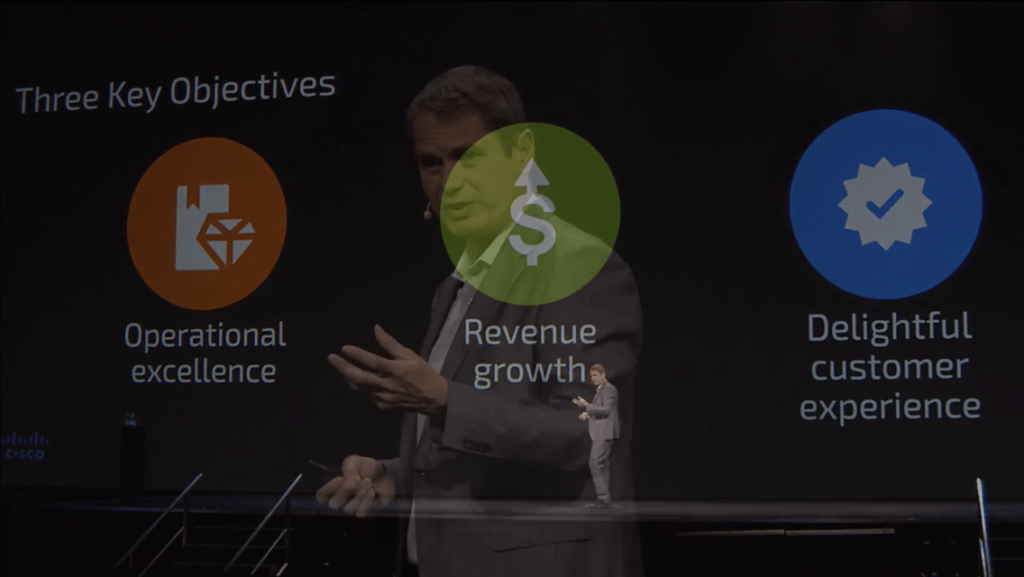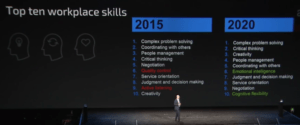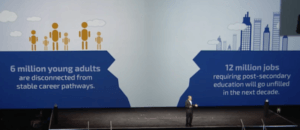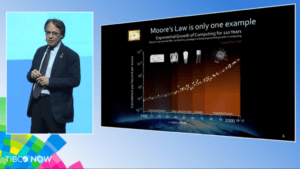I missed a couple of sessions, but made it back to Technicity in time for a panel on IoT moderated by Michael Ball of AGF Investments, featuring Zahra Rajani, VP Digital Experience at Jackman Reinvents, Ryan Lanyon, Autonomous Vehicle Working Group at City of Toronto, and Alex Miller, President of Esri Canada. The title of the panel is Drones, Driverless Cars and IoT, with a focus is on how intelligent devices are interacting with citizens in the context of a smart city. I used to work in remote sensing and geographic information systems (GIS), and having the head of Esri Canada talk about how GIS acts as a smart fabric on which these devices live is particularly interesting to me. Miller talked about how there needs to be a framework and processes for enabling smarter communities, from observation and measurement, data integation and management, visualization and mapping, analysis and modeling, planning and design, and decision-making, all the way to action. The vision is a self-aware community, where smart devices that are built into infrastructure and buildings can feed back into an integrated view that can inform and decide.
Lanyon talked about autonomous cars in the City of Toronto, from the standpoint of the required technology, public opinion, and cultural changes away from individual car ownership. Rajani followed with a brief on potential digital experiences that brands create for consumers, then we circled back to the other two participants about how the city can explore private-public sensor data sharing, whether for cars or retail stores or drones. They also discussed issues of drones in the city: not just regulations and safety, but the issue of sharing space both on and above the ground in a dense downtown core. A golf cart-sized pizza delivery robot is fine for the suburbs with few pedestrians, but just won’t work on Bay Street at rush hour.
The panel finished with a discussion on IoT for buildings, and the advantages of “sensorizing” our buildings. It goes back to being able to gather better data, whether it’s external local factors like pollution and traffic, internal measurements such as energy consumption, or visitor stats via beacons. There are various uses for the data collected, both by public and private sector organizations, but you can be sure that a lot of this ends up in those silos that Mark Fox referred to earlier today.
The morning finished with a keynote by John Tory, the mayor of Toronto. This week’s shuffling of City Council duties included designating Councillor Michelle Holland as Advocate for the Innovation Economy, since Tory feels that the city is not doing enough to enable innovation for the benefit of residents. Part of this is encouraging and supporting technology startups, but it’s also about bringing better technology to bear on digital constituent engagement. Just as I see with my private-sector clients, online customer experiences for many services are poor, internal processes are manual, and a lot of things only exist on paper. New digital services are starting to emerge at the city, but it’s a bit of a slow process and there’s a long road of innovation ahead. Toronto has made committments to innovation in technology as well as arts and culture, and is actively seeking to bring in new players and new investments. Tory sees the Kitchener-Waterloo technology corridor as a partner with the Toronto technology ecosystem, not a competitor: building a 21st century city requires bring the best tools and skills to bear on solving civic problems, and leveraging technology from Canadian companies brings benefits on both sides. We need to keep moving forward to turn Toronto into a genuinely smart city to better serve constituents and to save money at the same time, keeping us near or at the top of livable city rankings. He also promised that he will step down after a second term, if he gets it. 🙂
Breaking now for lunch, with afternoon sessions on open data and digital change agents.
By the way, I’m blogging using the WordPress Android app on a Nexus tablet today (aided by a Microsoft Universal Foldable Keyboard), which is great except it doesn’t have spell checking. I’ll review these posts later and fix typos.















